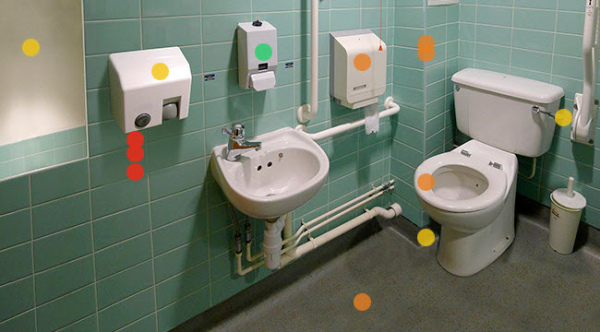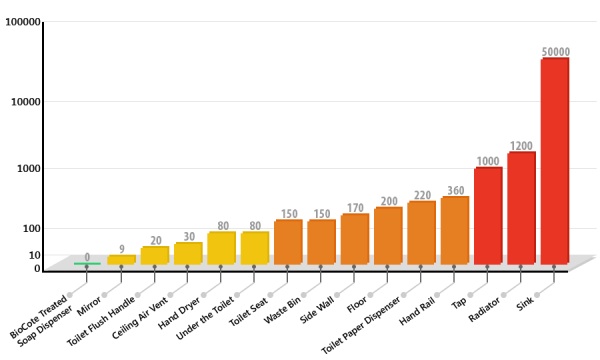
What restroom object would you pick for most contaminated surface? | Images courtesy of Biocote/Deb Group.
If you were to ask someone what object in the bathroom is the most contaminated with bacteria and mold, the answer you would receive is probably “the toilet seat." However a recent study by BioCote, shows that bacteria doesn’t always thrive in the places we would expect.
According to away-from-home skin care company, Deb Group, who reported on the findings, Biocote's microbiology experts took multiple samples from objects and surfaces in a public disabled toilet and tested them for levels of bacteria and mold.
"We took swabs from objects in a public restroom including sink, tap and toilet seat. What we found was analysed in the lab by growing and counting the bacteria collected," Dr Richard Hastings, Biocote technical director, told Deb.
Most people would assume that the toilet seat would be right at the top of the list for high levels of contamination, but the level of bacteria found on it was actually quite low. Topping the list was the sink itself which showed more than 50,000 Colony Forming Units (CFUs).
"In many cases germs are spread via touch so we can see that objects touched after people have used the toilet, but before they have washed their hands can be just as contaminated, " added Hastings.
The other interesting results were the levels of bacteria found on the less obvious objects and surfaces such as the floor, the wall and the underneath of the toilet.
Hastings explained, "This is probably because people only tend to clean the areas they can see, and the areas where they expect the bugs to grow. Unfortunately bacteria and mould can be found everywhere and they will just keep multiplying. We know most rooms are full of germs and although they may not necessarily be harmful, the higher the count, the greater the risk of illness."
Counts of Bacteria

The only object in the bathroom on which no traces of bacteria or mould were found was the soap dispenser, as manufactured by Deb and incorporating BioCote's antimicrobial technology.
"Whilst soap dispensers in public washrooms may often look physically clean, bacteria, germs and mould can in fact grow in-between cleanings as with any other surfaces," Hastings said.
Therefore, to reduce the risk of surface contamination the potential for cross-contamination, Deb has partnered with BioCote to incorporate their silver-based antibacterial agent in dispenser components at the point of manufacture.
As Hastings explained, "this inhibits the growth of a broad spectrum of bacteria, germs and mould by up to 99.9 percent over a 24-hour period. It's a safe, natural alternative to synthetic, organic antimicrobials like Triclosan and maintains its antimicrobial performance over the lifetime of the dispenser."
The BioCote study results support the common perception, that restrooms harbor high levels of bacteria. In addition, the application of antibacterial technology appears to reduce the presence of bacteria. The findings of this study suggest that antibacterial technology can contribute to the overall hygiene in public areas.

 The Down and Dirty on Cleaning in Virus Season
The Down and Dirty on Cleaning in Virus Season How Surfactant Use is Expanding in Commercial Cleaning
How Surfactant Use is Expanding in Commercial Cleaning